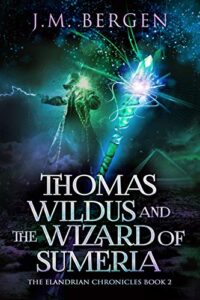

Cryptozoology for Beginners by Euphemia Whitmore with Matt Harry, illustrated by Juliane Crumb
Inkshares, 2019
ISBN-13: 978-1947848825
Available: Paperback, Kindle edition
The first thing you should know is that I have a cryptid-loving kid whose interest goes way back to when he was very little, so I am always on the lookout for books about cryptids. Usually those end up being some kind of nonfiction guide (such as Tales of the Cryptids by Kelly Milner Halls), maybe paired with a little background or local legend, or an adventure novel with kids either hunting for (or being hunted by) a particular creature (such as Roland Smith’s Chupacabra). In Cryptozoology for Beginners, we get a little of both, with the added element of a dash of magic.
That’s right, magic. Cryptozoology for Beginners is the second book in the Codex Arcanum series. The first book, Sorcery for Beginners, which I have not had the opportunity to read, follows Owen Macready and his friends Perry and Trish through adventures in magic that begin with bookseller and sorceress Euphemia Whitmore giving Owen the book Sorcery for Beginners when he ducks into her shop to escape from a bully, Brian Ferreti whose millionaire father turns out to be the book’s evil nemesis. This book is told in third person from Owen’s point of view and includes illustrated pages from his new grimoire, so that the reader is going through the learning process with Owen.
Cryptozoology for Beginners picks up in time for the teens’ summer vacation. Owen and Perry have become a couple, and the book is told in third person from Trish’s point of view. An organization called the Euclideans, who seek to destroy magic, which is in direct conflict with the sorcerers, has started kidnapping cryptids for scientific experimentation. Euphemia Whitmore returns to ask for their help in collecting (or capturing) the remaining cryptids for a “zoo” that will be a safe haven for them, away from the Euclideans. They are in a race to preserve these rare, frequently legendary creatures before the Euclideans can capture them for their own nefarious purposes.
Perry, Owen, and Trish are joined by Brian, the bully from the previous book, who wants to redeem himself, under the supervision of slightly older Jacinda Greyeyes (who is very clear that she is a member of the Flying Dust First Nation), for an adventure in an RV that leads them all over the country tracking down and capturing such creatures as jackalopes, the altamaha-ha, and the chupacabra, with the help of an illustrated, informative guide to cryptids provided by Euphemia Whitmore, Cryptozoology for Beginners. As in the first book, fully illustrated pages from the guide are included at strategic points in the book, so the reader learns about the appearance and habits of the jackalope as the group is chasing after one. As the Euclideans gain ground on the sorcerers, Trish, Perry, Owen, Brian, and Jacinda find themselves also traveling across the Atlantic to help save the Loch Ness Monster, the sphinx, and many others. They finally find themselves in the heart of the Euclideans’ headquarters, where they see some of the results of the experimentation firsthand, and it’s heartbreaking. The plot moves fairly quickly, and we see a fair amount of character development in the prickly Trish and the obnoxious Brian.
Trish, feeling somewhat like a third wheel at the beginning of the book, starts falling for Jacinda and discovers her feelings are returned. She gains confidence and becomes more of a leader. Brian, who’s pretty rough around the edges, strained my ability to believe he could be redeemed, as he made a number of racist and dismissive comments about Jacinda’s indigenous identity, but he did commit some selfless acts, and become slightly more bearable. There was definitely growth to his character, but I hope there’s a third book that gives him opportunities to continue to change. Owen and Perry don’t have a lot of character development going on, although Owen makes a discovery about his mother that requires him to make some uncomfortable decisions.
But what I love most about this book is the cryptids and the seriousness they’re taken with in the story, even though it’s fiction. The pages devoted to the various creatures are well designed and illustrated, and readers who haven’t encountered cryptids before will be pulled into the story as the learn something about them at the same time as the kids.
While the romance might not appeal to all middle-grade readers, many will enjoy the adventure. For cryptid-loving kids, it can stand alone, but it’s better if read after Sorcery for Beginners. Recommended for middle-grade readers who enjoy creature guides and adventure with some fantasy in the mix.







Follow Us!